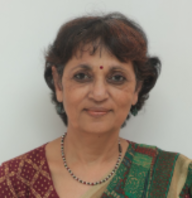-
A Journey through Bioenergetic Metabolism

ICNC2024
Frank Ford Award LectureA Journey through Bioenergetic Metabolism
Ingrid Tein -
A short journey through paintings based on children’s images

ICNC2024
Medicine and ArtA short journey through paintings based on children’s images
Haluk Topaloğlu -
Advances in genetics of Autism in African populations: Evolving concepts

ICNC2024
Symposia: Current Concepts In Autism Spectrum Disorder
Advances in genetics of Autism in African populations: Evolving concepts
Kirsten Donald -
Artificial Intelligence in the diagnosis of epilepsy in resource poor areas.

ICNC2024
Symposia: Big Data, Artificial Intelligence and Machine Learning In The Diagnosis and Management of EpilepsyArtificial Intelligence in the diagnosis of epilepsy in resource-poor areas.
Charles Newton -
Autism Spectrum Disorders & other neuro-developmental disabilities in low resource contexts: Technological advancements in African setting

ICNC2024
Symposia: Current Concepts In Autism Spectrum DisorderAutism Spectrum Disorders & other neuro-developmental disabilities in low resource contexts: Technological advancements in African setting
Petrus De Vries -
Avoiding and Managing Conflict in the PICU

ICNC2024
Paediatric Neuropalliative Medicine - Providing Holistic Care To FamiliesAvoiding and Managing Conflict in the PICU
Peter Sedgwick -
Brain connectivity with EEG and neuroradiologic modalities in developmental epileptic encephalopathy with spike-and-wave activation in sleep

ICNC2024
Symposia: Epilepsy As A Brain Network Disease: Implications For The Clinician
Brain connectivity with EEG and neuroradiologic modalities in developmental epileptic encephalopathy with spike-and-wave activation in sleep
Hasan Tekgul -
Can we prevent SUDEP

ICNC2024
Symposia: Addressing The Restrictions and Mortality In The Lives of Children With EpilepsyCan we prevent SUDEP
Rajesh Ramachandran Nair -
Child neurology practice in a low resource setting, focus on Epilepsy, lessons learnt

ICNC2024
Sheila Wallace Award
Child neurology practice in a low resource setting, focus on Epilepsy, lessons learnt
Robert K Sebunya -
Chronic headaches in children and adolescents: Dilemma in diagnosis and management

ICNC2024
Symposia: Pediatric Headaches With The Challenges of The New NormalChronic headaches in children and adolescents: Dilemma in diagnosis and management
Shahnaz Ibrahim -
Climate change and child neurology implications.

ICNC2024
Plenary Talk
Climate change and child neurology implications (Online)
Madeleine Thomson -
Clinicial Vignettes in Paediatric NeuroPalliative care

ICNC2026
Symposia: Paediatric Neuropalliative Medicine - Providing Holistic Care To FamiliesClinicial Vignettes in Paediatric NeuroPalliative care
Viraj Sanghi -
Definitions and terminology of complex febrile seizures - is a subclassification required

ICNC2024
The Tangled Web of Complex Febrile Seizures: A Common But Complex Conundrum
Definitions and terminology of complex febrile seizures - is a subclassification required
Rekha Mittal -
Diagnosing Genetic Epilepsy in a Resource-Constrained Setting – the South African experience

ICNC2024
Symposia: The Impact of Genetics In The Care of Patients With Rare Pediatric Epilepsies: Past, Present FutureDiagnosing Genetic Epilepsy in a Resource-Constrained Setting – the South African experience.
Alina Esterhuizen -
Diagnosing MOGAD in pediatric patients. Updated diagnostic criteria from an International Panel.

ICNC2024
Symposia: What Is New In Pediatric CNS Demyelination?Diagnosing MOGAD in pediatric patients. Updated diagnostic criteria from an International Panel.
Silvia Tenembaum -
Diagnostic testing (EEG, MRI, CSF studies) in Complex Febrile Seizures: when and why, and are they overdone?

ICNC2024
The Tangled Web of Complex Febrile Seizures: A Common But Complex Conundrum
Diagnostic testing (EEG, MRI, CSF studies) in Complex Febrile Seizures: when and why, and are they overdone?
Puneet Jain -
Dystonia related to neurometabolic disorders and their treatment

ICNC2024
Update On The Diagnostic Approach and Treatment In Children With DystoniaDystonia related to neurometabolic disorders and their treatment
Michèl Willemsen -
Early intervention in autism spectrum disorder: Early is how early and Focus on interdisciplinary management of behavior in Autism and other neurodevelopmental disorders

ICNC2024
Symposia: Current Concepts In Autism Spectrum DisorderEarly intervention in autism spectrum disorder: Early is how early and Focus on interdisciplinary management of behavior in Autism and other neurodevelopmental disorders
Sheffali Gulati -
Empowering Families Through Technology: a Mobile-Health Project to Reduce the TAND Identification and Treatment Gap (TANDem)

ICNC2024
Symposia: Managing The Complexities of TSC - From mTOR Inhibition and CBD To TechnologyEmpowering Families Through Technology: a Mobile-Health Project to Reduce the TAND Identification and Treatment Gap (TANDem)
Tosca Heunis -
Engaging parent partners to improve the science: Lessons from the Neonatal Seizure Registry

ICNC2024
Symposia: Engaging Parents and Stakeholders To Advance Scientific Research In Child NeurologyEngaging parent partners to improve the science: Lessons from the Neonatal Seizure Registry
Hannah Glass -
Engaging Patients & Families in Research: The Global Parent and Stakeholder Perspective

ICNC2024
Symposia: Engaging Parents and Stakeholders To Advance Scientific Research In Child NeurologyEngaging Patients & Families in Research: The Global Parent and Stakeholder Perspective
Jolene Kruger -
Epidemiology of Autism & Neurodevelopmental Disorders

ICNC2024
Symposia: Current Concepts In Autism Spectrum DisorderEpidemiology of Autism & Neurodevelopmental Disorders
Charles RJC Newton -
Epigenetic approaches to epilepsy diagnosis

ICNC2024
Symposia: The Impact of Genetics In The Care of Patients With Rare Pediatric Epilepsies: Past, Present FutureEpigenetic approaches to epilepsy diagnosis
Heather Mefford -
Epilepsy as a network disease

ICNC2024
Symposia: Epilepsy As A Brain Network Disease: Implications For The ClinicianEpilepsy as a network disease
Lieven Lagae -
Generative models of brain dynamics in epilepsy

ICNC2024
Symposia: Big Data, Artificial Intelligence and Machine Learning In The Diagnosis and Management of EpilepsyGenerative models of brain dynamics in epilepsy
Jamie Norris
Page 1 of 3
